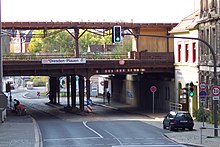The red cockatoo
| Movie | |
|---|---|
| Original title | The red cockatoo |
| Country of production | Germany |
| original language | German |
| Publishing year | 2006 |
| length | 128 minutes |
| Age rating | FSK 12 |
| Rod | |
| Director | Dominik Graf |
| script |
Karin Åström , Michael Klier , Günter Schütter (editing) |
| production | Manuela Stehr |
| music | Dieter Schleip |
| camera | Benedict Neuenfels |
| cut | Christel Suckow |
| occupation | |
| |
Der Rote Kakadu is a German love drama from 2006 directed by Dominik Graf , which tells the story of a young man in the GDR . The film is based on memories and a script by Michael Klier and is named after a legendary Dresden dance bar, the GDR's first “ jazz cellar ”.
action
The young Siggi is a talented draftsman and wants to study stage design at the Leipzig Theater School. For this he comes in the spring of 1961 - four months before the Berlin Wall - to Dresden to the State Theater Dresden experience to be gained. He lives there with his aunt Hedy, who also works as an opera singer at the State Theater.
He gets to know the poet Luise and her husband Wolle, who tell him about the hip dance club “Roter Kakadu”. This restaurant in the villa district of Weißer Hirsch am Elbhang is a meeting point for Dresden 's youngsters who are enthusiastic about rock 'n' roll . Siggi likes it there very much. He sells a Meissen porcelain monkey from his aunt in West Berlin and thus secures himself financially.
Wool is arrested by the State Security . While he is in prison, Siggi has Luise's poems printed. She is touched when she holds the book in her hand, but fears for the freedom of Siggi, wool and herself. All three are arrested and brought to justice. Siggi is acquitted, although he has not allowed himself to be instrumentalized, but is supposed to serve as an involuntary informant by the Stasi about the wrongdoing and misdemeanor of his relatives and friends. After wool and Luise were convicted, they suspect treason. Wool tries to escape from the courthouse and is shot.
A short time later, the construction of the wall began. After Siggi has convinced Luise of his innocence, he wants to flee to the West with her. Siggi sets off immediately. Luise wants to follow him later as soon as she gets wool out; however, it no longer comes.
Reviews
“Elaborately staged equipment cinema that confidently combines facts and fiction into a narrative rich in detail and episodes. Above all, the comprehensible and convincingly interpreted characters convey something of the idealistic way of life in the short period of time before the wall was built. "
“Dominik Graf makes political cinema that is not satisfied with slogans. There are moments, again and again, with him when the screen seems to ignite, which takes his film far beyond similar films since Good Bye, Lenin! out. "
Awards
- Max Riemelt received the Bavarian Film Prize in 2006 for his role as Best Young Actor .
- The film received the Golden Star Grand Prix at the 6th Marrakech International Film Festival in 2006 .
- Dominik Graf received the award for Best Director at the Madrid Móstoles International Film Festival in 2007
background
The film was mainly shot in Dresden. In addition, the Blue Wonder was closed for a few days and the Altplauen street at Plauen train station for one day . This station was converted into a border crossing between the GDR and the French sector , which plays a central role in the film alongside the dance hall.
In Berlin, too, the Kurfürstendamm between Olivaer and Adenauerplatz was closed on both sides for eight hours. For the approval, 51.13 euros per day had to be paid. Since parking spaces that could not be occupied on that day also had to be paid for, the total cost was 1,070 euros. Further scenes were created on Kopenhagener Strasse in the Prenzlauer Berg district .
When asked about Dominik Graf's comment at a Dresden press conference in the Luisenhof on the Weißen Hirsch that the film should be absolutely authentic, Manfred Schulz, drummer of the Theo Schumann Combo , commented on the project in an interview with Ray van Zeschau in the Dresden culture magazine to let a rock 'n' roll band perform in the Kakadu as follows: “This is total nonsense, cheese, shot in the oven, back then nobody played rock'n'roll and not at all in 'Roten Cockatoo '. "
The film was supported with funds from the film subsidy: Mitteldeutsche Filmförderung (900,000 euros), Medienboard Berlin-Brandenburg (800,000 euros), Film Funding Agency (500,000 euros).
Web links
- The Red Cockatoo in the Internet Movie Database (English)
- The Red Cockatoo at filmportal.de (with trailer and photo gallery)
- Film booklet (PDF) Federal Agency for Civic Education (Germany)
- The Red Cockatoo at crew united
- Photos from the shooting in Berlin at filmfotos-berlin.de , accessed on December 17, 2015
Individual evidence
- ^ Certificate of release for The Red Cockatoo . Voluntary self-regulation of the film industry , February 2006 (PDF; test number: 105 191 K).
- ↑ The Red Cockatoo. In: Lexicon of International Films . Film service , accessed March 2, 2017 .
- ↑ The mother's skirt wobbles . Süddeutsche Zeitung , February 14, 2006
- ↑ Portrait at deutsches-filmhaus.de, accessed on March 12, 2019
- ↑ Today only buses on Ku'damm - Boulevard will be closed due to filming . In: Der Tagesspiegel , September 28, 2004
- ↑ Ray van Zeschau : VIP TIP . In: Dresdner Kulturmagazin , September 2004; Column / interview
- ↑ Data sheet for the film at crew-united.com , accessed on January 8, 2013

